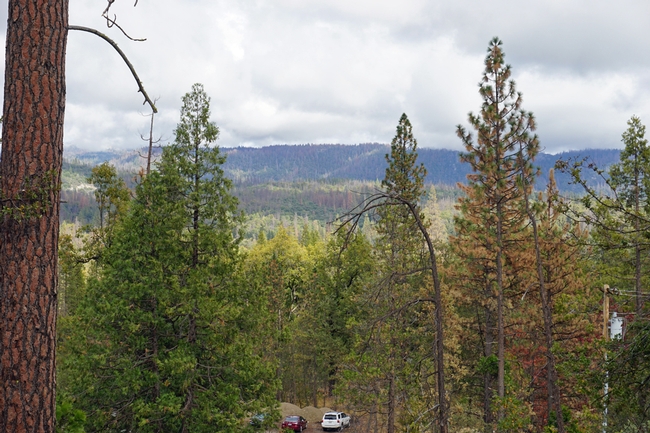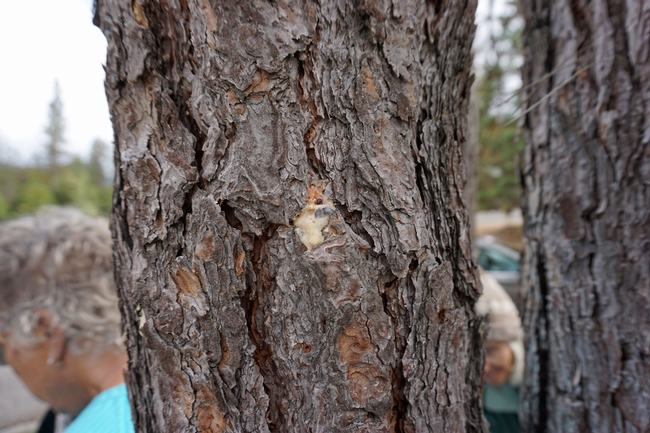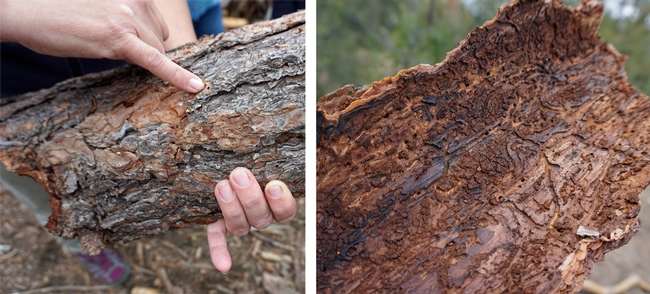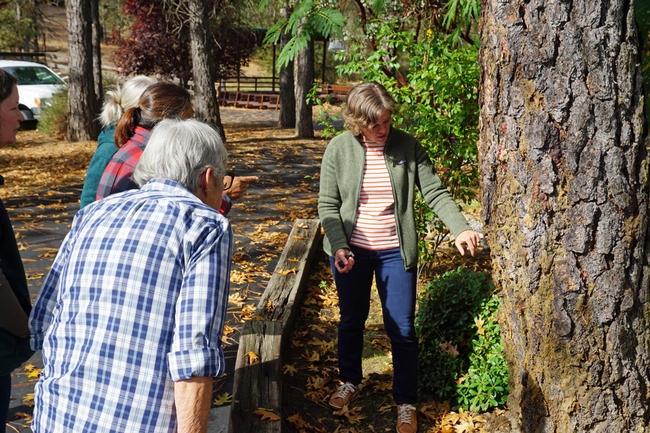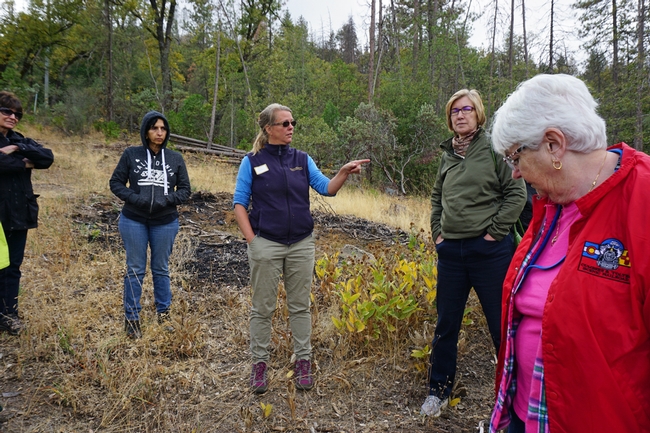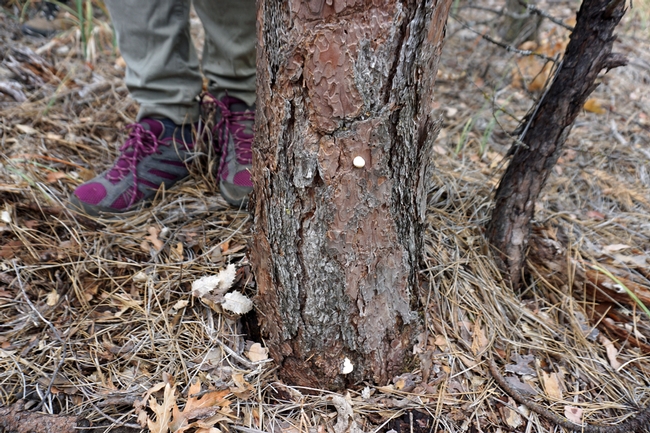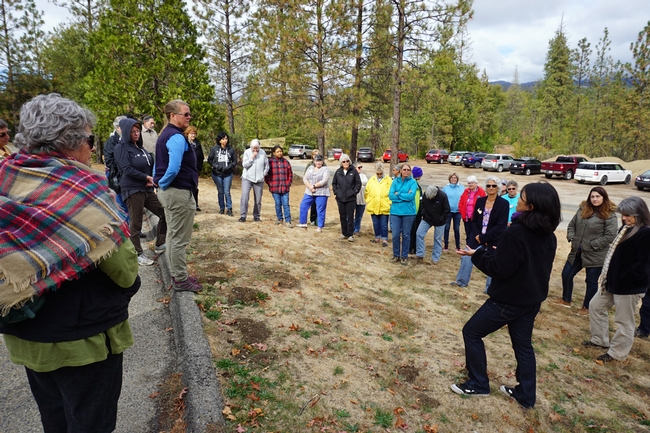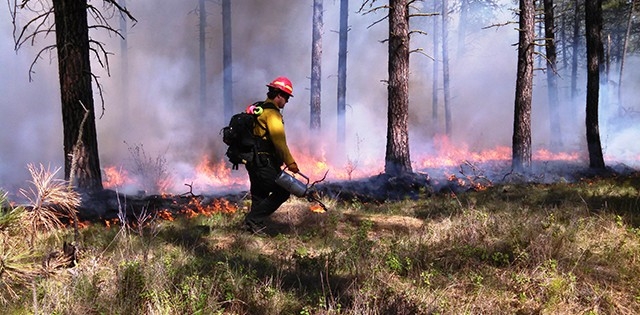Posts Tagged: Jodi Axelson
April News Clips
This geneticist is creating gene-edited animals for our plates
(Ozy.com) Marissa Fessenden, April 29
Animal geneticist Alison Van Eenennaam has six calves that are rather unusual. Most people might not pick up on what's odd, but close inspection, and knowledge of bovine genetics, reveals that none of the calves have horns despite being a mix of breeds that typically have them. Even more surprising? The calves' hornless state wasn't bred into them — Van Eenennaam and her colleagues edited their genes using the new CRISPR technology.
Board approves mural honoring Orloff, Siskiyou's heritage
(Siskiyou Daily) Danielle Jester, April 19
A mural that will honor the late Steve Orloff, former Siskiyou County farm advisor, and recognize agriculture in the county was approved Tuesday by the Siskiyou County Board of Supervisors.
Rob Wilson, who is the director and farm advisor at the Intermountain Research Center Extension in Tulelake and is serving as the the interim acting county director for Siskiyou County Cooperative Extension, noted that the mural presents a "great opportunity to honor agriculture in Siskiyou County and to try to honor former Farm Advisor Steve Orloff."
http://www.siskiyoudaily.com/news/20180419/board-approves-mural-honoring-orloff-siskiyous-heritage
Letter: Livestock impact on environment overstated in 'Meatless Monday' column
(Lafayette IN Journal & Courier) Frank Mitloehner
I am responding to the recent contribution titled, “Meatless Mondays: Consequences for our dining habits."
What a nutritionist wants you to know about pesticides and produce
(NBC News) Samantha Cassetty, April 15
This week, the Environmental Working Group (EWG) released an update to their annual Dirty Dozen and Clean 15 lists. These lists reveal produce with both the highest and lowest levels of pesticide residue, according to their methodology. The report looks more or less the same as last year's guide, with strawberries claiming the unfortunate number one spot, edging out spinach and nectarines.
… But let's get one thing clear: Organic produce is not pesticide-free. There are pesticides used in organic farming, but they're derived from natural substances rather than synthetic ones, And as Carl Winter, Ph.D., Extension Food Toxicologist and Vice Chair, Food Science and Technology at University of California, Davis puts it, in either case, “the dose makes the poison.”
OPINION: Should California Winemakers Be Worried About China's Tariffs?
(NPR) Julian M. Alston, director, Mondavi Institute for Wine Economics, UC Davis; Daniel Sumner, Olena Sambucci, Agricultural and Resource Economics, UC Davis
California's vintners and grape growers are among the latest potential victims in the escalating trade spat between the U.S. and China.
Responding to U.S. plans to impose import duties on goods from China, the Chinese Ministry of Commerce reciprocated by introducing new tariffs on 128 U.S. products, including an additional 15 percent import tariff on wine.
"We are open for business" is message from wine committee joint meeting
(Sonoma West) Heather Bailey, April 9
At the April 6 Joint Information Hearing of the California State Senate Select Committee on California's Wine Industry and the California Assembly Select Committee on Wine the overarching theme of the meeting was: “We are open for business.” While there are impacts from the October fires, the message went, stories of our demise are greatly exaggerated. So come on down for your corporate event, wine tasting weekend, wedding or bachelorette party.
…The final panel on Water Supply featured Glenn McGourty, Viticulture and Plant Science Advisor in Mendocino County for the UC Cooperative Extension, Dr. Michael Anderson, California State Climatologist at the California Department of Water Resources, Eric Larson, Environmental Program Manager at the California Department of Fish and Wildlife, and Katie Jackson, Vice President for External Affairs and Sustainability at Jackson Family Wines.
McGourty discussed some of the scientific advances being brought to bear for assisting the wine industry with its water usage, including surface renewal technology, which will tell a grower exactly how much and when to irrigate and could save 50 to 100,000 gallons of water per acre, using crop cover on the soils, which allows soil in one acre to hold an additional 38,000 more gallons of water, and various ways to control frost in vineyards so that irrigation isn't needed to prevent frost.
County program to cull dead trees continues
(The Union Democrat) Alex Maclean, April 5
Scientists doing field-based research saw a decline in the death rate of ponderosa pines from western bark beetle infestation last year, but Tuolumne County isn't slowing down its effort to help landowners affected by the drought-induced epidemic.
… Jodi Axelson, a Cooperative Extension specialist in forest health at University of California, Berkeley, said the slowing of mortality seen over the past year should give counties like Tuolumne an opportunity to catch up on removing dead trees from private property.
Axelson is part of a team of scientists collecting data on tree mortality that also includes John Battles, a forest ecology professor at UC Berkeley, and Susie Kocher, a natural resources advisor for UC Cooperative Extension, Central Sierra.
http://www.uniondemocrat.com/localnews/6140772-151/county-program-to-cull-dead-trees-continues
Land suitable for certain California crops expected to shrink
(Agri-Pulse) Steve Davies, April 5
California growers should start to look seriously at how to adapt to a changing climate, which could shrink the land available for many of the state's most popular crops, a new study has found.
“Reduced numbers of chill hours, increased pest pressure, increased water demand and water-induced stress, as well as variable and unreliable water supply, are examples of factors that are projected to adversely impact the yield and quality of various crops grown in California,” says the paper, published in the journal Agronomy. Chill hours are traditionally defined as those periods where the temperature is below 45 degrees Fahrenheit.
"Understanding climate change and how it is impacting agriculture can help us develop relevant adaptation strategies and enhance agricultural resilience to climate risks," said lead author Tapan Pathak, a cooperative extension specialist at the University of California Division of Agriculture and Natural Resources.
Search for wine ‘smoke taint' solutions intensifies after Northern California wildfires
(North Bay Business Journal) Jeff Quackenbush, April 4
The international pursuit of ways to predict how much smoke from a wildfire will end up in finished wine and what to do about it got a boost when the dark clouds of particles pumped out by the massive North Bay fires in October descended on the University of California, Davis, experimental vineyard in Napa Valley.
“The moment the smoke started, my phone started ringing off the hook,” said Anita Olberholster, Ph.D., a specialist in the science of winemaking for University of California Cooperative Extension. When the fires erupted Oct. 8, most of the North Coast winegrape crop had been picked, but some late-ripening fruit, particularly cabernet sauvignon was still on the vine, in the home stretch of the 2017 harvest. “It quickly realized how thin the data is I need to base recommendations on.”
For these Central Coast students, spring break is a chance to hone their culinary skills
KSBY, April 4
Some local fifth and sixth graders are spending their spring break in the kitchen.
The students are part of the 4-H Student Nutrition Advisory Council clubs at five schools in Santa Maria and Oceano.
During the third annual "Culinary Academy," they're learning food safety habits, how to safely handle knives, baking techniques, and stovetop skills. Specifically, they're cooking up healthy blueberry muffins, sushi, and an egg omelet.
"It's really an opportunity for the kids to learn some basic food skills along with nutrition and some fun thrown in there, too," said Janelle Hansen, 4-H program supervisor for Santa Barbara County.
Culinary Academy teaches Santa Maria spring breakers how to cook
Santa Maria Times, April 4
Fifth and sixth grade youth leaders from five school-based 4-H Student Nutrition Advisory Council clubs (SNAC) worked to develop their culinary skills over Spring Break.
Over 20 SNAC Youth leaders participated in the 3rd annual Culinary Academy, at Liberty Elementary School in Santa Maria. This year youth worked on recipes to enhance their knife and stove top skills, food safety habits, and baking techniques.
UC Climate Video Questioned by UC Researchers
(UCD Aggie) David Madey, April 4
According to a video called “The diet that helps fight climate change” released by the Office of the UC President, everyone — including the 238,000 students across the UC system — can help combat climate change on their own. But not everyone is celebrating.
… “[The video] recommended for the global population a diet that only the top one percent can afford,” said Dr. Frank Mitloehner, a professor and air quality specialist at UC Davis. “We could not even satisfy a Mediterranean diet for the entire United States population today.”
… Dr. Glenda Humiston, the vice president for the UC Division of Agriculture and Natural Resources, wrote in a public letter to UC colleagues, “[The video] states that if the world was to reduce its meat consumption, that decision alone could offset the emissions from a billion cars on the road by 2050. For the U.S., however, this contention is misleading, as the impact would be considerably smaller.”
Dr. Alison Van Eenennaam, an expert featured in “Food Evolution” from UC Davis, also claims that the Climate Lab video is misleading. With a combined 2.1 million views on YouTube and Facebook to date, Van Eenennaam expressed concern that the public is led to believe that diet is twice as important as transportation effects –– which is not true at all, she said.
“It's not simple, and that video made it simple,” Van Eenennaam said.
https://theaggie.org/2018/04/04/can-diet-diminish-climate-change-see-video.
Future Of Farming Blossoming At UC Davis
(CBS Sacramento)
Researchers are looking for ways to make farming a little smarter with robots and drones that could one day revolutionize the way our food is grown.
Engineers at UC Davis are trying to be on the forefront of future farming technology.
“Smart technologies are going to allow us to be more efficient,” said professor David Slaughter.
They're inventing things like a high-tech hoe that uses ultraviolet lights and cameras along with specially treated plants to trim away weeds. Computer-controlled red cutting blades open up just in time to let plant stems pass by unharmed.
http://sacramento.cbslocal.com/2018/04/03/uc-davis-farming-future-robots/
Drought put UC's water-saving strategies into practice
(Western Farm Press) Tim Hearden
The historic drought from 2012 to 2016 forced almond growers to put into practice water-conservation strategies they'd been taught by University of California Cooperative Extension crop advisors — so say a farmer and an advisor in a newly released video on water management.
Raj Meena of the Gustine, Calif.-based Meena Farms, says tools such as the pressure chamber, which measures water stress in trees, and soil moisture monitoring helped the operation survive drastic cutbacks in water. “I would say our water management improved considerably because it had to,” he says in the video, part of series on drought tips from the UC California Institute for Water Resources. “If we hadn't done that, we wouldn't still be farming. When you're so regulated in the water that you have, you have to allocate it very carefully.”
http://www.westernfarmpress.com/tree-nuts/drought-put-uc-s-water-saving-strategies-practice
UC program aids in citrus disease fight
(AgAlert) Christine Souza
At war with the Asian citrus psyllid since it was found in San Diego County in 2008, California citrus growers and packers have had unprecedented success in slowing the spread of the tree-killing bacteria the psyllid can carry. People in the citrus business say part of that success relates to the testing and distribution of clean citrus plant material through the University of California, Riverside.
The Citrus Clonal Protection Program at UC Riverside tests clonal material to ensure that citrus varieties introduced into California remain free of pathogens.
Joel Nelsen, president of California Citrus Mutual, said he believes work such as that done by the program has helped defend California citrus from the tree-killing bacterial disease huanglongbing or HLB, also called citrus greening.
http://agalert.com/story/?id=11738
California fights costly battle against invasive species
(Agri-Pulse) Tyler Ash
Every year, California acquires on average nine new invasive species, including exotic insects, spiders, mollusks and even South American mammals. Three of those invaders usually try and settle down, start a large family and stake a claim on some of the Golden State's endless buffet of agricultural crops, becoming the bane of farmers and researchers.
“There are lots of species that get here and don't become established, it's just a few that do,” said Jim Farrar, director of the Statewide Integrated Pest Management Program of the University of California Division of Agriculture and Natural Resources.
According to the UC-Riverside's Center for Invasive Species Research, invasive pests cost the state an estimated $3 billion a year. Intrusive plants alone cost California at least $82 million annually for control, monitoring and outreach, not including crop loss, as reported by the California Invasive Plant Council.
https://www.agri-pulse.com/articles/10774-california-fights-costly-battle-against-invasive-species
UC Davis researchers on a hunt for backyard chicken eggs around the Thomas Fire burn scar
(Ventura County Star) Cheri Carlson, April 3
Veterinarians at UC Davis have put out a call for eggs from California's backyard chicken owners, particularly those living near the Thomas Fire and other recent blazes.
They want to test the eggs for free in an effort to understand how they might be affected by wildfires, lead and other environmental factors.
It's called the Backyard Chicken Egg Study. And, they need help from backyard chicken enthusiasts, said Maurice Pitesky, a faculty member at the UC Davis School of Veterinary Medicine-UC Cooperative Extension.
“We're trying to understand the connection between the environment and our backyard chickens,” said Pitesky, who teamed up with colleague Birgit Puschner to test the eggs.
Related:
Backyard Chicken Owners Can Have Eggs Tested For Free By UC Researchers
(SF Gate) Bay City News Service, April 3, 2018
Bay Area Chicken Owners: UC Testing Eggs For Free
(Bay City News Service)
Replanting the Sierra Nevada after an ecological catastrophe
Given California's changing climate, should Sierra Nevada residents replant pine trees after so many died during the 2010-2016 drought? The short answer is yes, says Susie Kocher, UC Cooperative Extension forestry advisor.
“We have every reason to believe that pines will continue to be an important part of mixed conifer forests in the Sierras,” Kocher said.
Kocher spoke at a meeting for UC Master Gardeners, volunteers who provide landscape advice to the public in California. Questions have been coming in to Master Gardener hotlines from mountain residents wondering what to do after unprecedented tree loses in the last few years.
Most California forests are suffering from severe overcrowding due to 100 years of aggressive fire suppression and selective harvesting of the largest and most resilient trees. They were then subjected to five years of drought.
“There were just too many stems in the ground,” Kocher said. “The drought was very warm, so trees needed more water, but got less. These were optimal conditions for bark beetles.”
Western pine beetle is a native pest that attacks larger ponderosa pine and Coulter pine trees weakened by disease, fire, injury or water stress. Bark beetles are tree species specific, so other beetles target other species of trees in California's mixed conifer forests. Typically, bark beetles bore through tree bark and create long winding tunnels in the phloem. An aggregating pheromone attracts additional bark beetles to the tree, and heavily attacked trees invariably die.
During the drought, 102 million Sierra Nevada trees died from bark beetle attack or simply lack of water; 68 million of those died in 2016 alone. But after the abundant rainfall in the 2016-17 season, the bark beetle population seems to have crashed.
Landowners with 20 acres or more may be eligible for a state cost-sharing program to remove trees, reduce the fire hazard and replant new seedlings. Landowners in mountain communities who wish to revitalize their properties can contact local UC Master Gardeners for recovery advice.
UC Master Gardeners are plant enthusiasts who have passed an intense training program presented by UC academics. They participate in continuing education annually to update and maintain their knowledge. More than 60 Master Gardeners from Mariposa, Madera and Fresno counties gathered in Oakhurst in October to learn from UC scientists how to work with mountain homeowners whose towering trees have died. Similar training sessions, all funded by a grant from UC Agriculture and Natural Resources, were held in El Dorado and Tuolumne counties in June.
“There is life after beetles,” said Jodi Axelson, UC Cooperative Extension forestry specialist at UC Berkeley.
“Eco systems are stretched, and then they come back,” she said. “You must remember the time scale of forest change is long and pines have been a major species in the Sierra Nevada for at least 28,000 years. As long as there have been pines, there have been bark beetles.”
The scientists suggest that people who own forestland take a step back and assess the landscape after their dead trees have been removed.
“We're seeing a lot of young cedar and white fir surviving the drought. Oaks seem to be doing really well,” Kocher said.
She suggests landowners thin young trees so available sun and soil moisture are focused on the healthiest trees. Water seedlings that are receiving more sun than before to reduce stress. Planting native conifers is the best option. Due to climate change, she recommends choosing trees from a slightly lower elevation to hedge against warmer temperatures in the future.
Pines are adapted to the California forest, but may need help to regenerate. When the ground is moist in the late fall or spring, plant seedlings 10 to 14 feet apart. New trees should be planted well away from homes to maintain defensible space and at least 10 feet from power lines.
“Please don't set them up for future torture,” Kocher said. “That's just sad.”
To help the new trees become established, cover the ground around the tree, but not touching the bark, with two or three inches of mulch and irrigate weekly during the dry season for the first few years.
Questions about special circumstances may be directed to local UC Master Gardeners. Find the local program here: http://mg.ucanr.edu/FindUs/
Decreasing forest density will reduce fire risk, build climate resilience
California needs to increase the pace and scale of efforts to improve the health of its headwater forests — the source of two-thirds of the state's surface water supply. Management techniques including prescribed fire, managed wildfire and mechanical thinning can help rebuild resilience in these forests and prepare them for a challenging future.
These are among the key findings of a report released today by the PPIC Water Policy Center.
Decades of fire suppression have increased the density of trees and other fuels in headwater forests to uncharacteristically high levels and resulted in massive tree die-offs and large, severe wildfires. Improving forest health will require reducing the density of small trees and fuels on a massive scale.
This will require changes in the regulation, administration, and management of forests. Many of the recommended reforms in forest management can take place at low or no cost. But implementing them will require vision, determined leadership by state and federal officials, and the backing of an informed public.
“Actions to arrest the decline in forest health will take place far from urban centers,” said Van Butsic, a coauthor of the report and a UC Cooperative Extension specialist in the Department of Environmental Science, Policy and Management at UC Berkeley. “But all Californians will benefit through continued supplies of high-quality water, natural environments, forest products and recreational landscapes.”
Changing the way forestry work is funded — and in some cases securing new funding — will also be needed to help expedite forest improvements. The authors suggest reforms that will enable the private sector and government agencies to use existing tools and funding opportunities more effectively and collaborate more easily on larger-scale management projects. One key recommendation is to find opportunities to combine revenue-generating timber harvesting with other management work to help offset the costs of efforts to improve forest health.
“Making forest health a top land management priority for public and private lands would be a critical first step in reversing the degraded condition of the state's headwater forests,” said report coauthor Henry McCann, a research associate with the PPIC Water Policy Center.
The report, Improving the Health of California's Headwater Forests, was supported with funding from the S. D. Bechtel, Jr. Foundation and the US Environmental Protection Agency. In addition to Butsic and McCann, the coauthors are Jeffrey Mount and Brian Gray, both senior fellows at the PPIC Water Policy Center; Jodi Axelson, a UC Cooperative Extension specialist at UC Berkeley; Yufang Jin, an assistant professor in the Department of Land, Air, and Water Resources at UC Davis; Scott Stephens, professor of fire science and co-director of the Center for Forestry and Center for Fire Research and Outreach at UC Berkeley; and William Stewart, a UC Cooperative Extension specialist and co-director of the Center for Forestry and Center for Fire Research and Outreach at the UC Berkeley.

